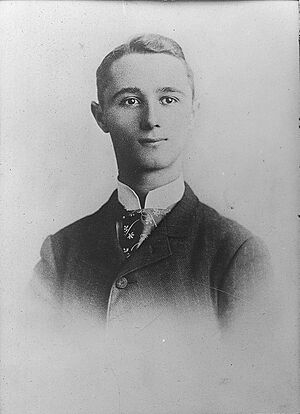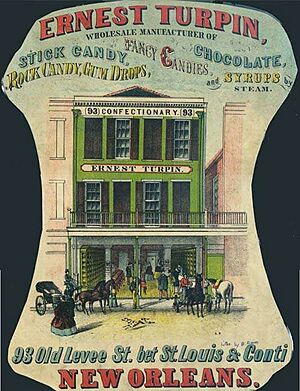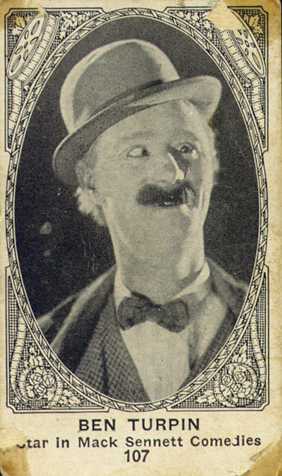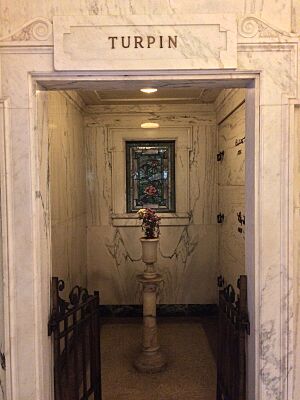Ben Turpin facts for kids
Quick facts for kids Ben Turpin |
|
|---|---|
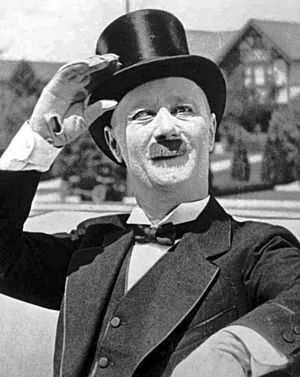
Turpin in the 1920s
|
|
| Birth name | Bernard Turpin |
| Born | September 19, 1869 New Orleans, Louisiana, U.S. |
| Died | July 1, 1940 (aged 70) Santa Monica, California, U.S. |
| Resting place | Forest Lawn Memorial Park, Glendale, California |
| Medium | Comedian, actor |
| Years active | 1907–1940 |
| Genres | Silent films |
| Spouse |
Carrie Lemieux
(m. 1907; Babette Dietz
(m. 1926) |
Bernard "Ben" Turpin (born September 19, 1869 – died July 1, 1940) was a famous American comedian and actor. He is best known for his work in silent films, which were movies without sound.
Ben Turpin's special trademarks were his crossed eyes and his amazing skills at physical comedy. He worked with other well-known stars like Charlie Chaplin and Laurel and Hardy. He was also part of the team at Mack Sennett's movie studio. Many people believe he was the first person to get a "pie in the face" in a movie! When movies started having sound, Turpin decided to retire. He had made smart investments in real estate, so he didn't need to work anymore. However, he still made a few short appearances in movies.
Contents
About Ben Turpin's Life
Ben Turpin was born in New Orleans, Louisiana, on September 19, 1869. His father, Ernest Turpin, owned a candy store.
Ben Turpin married his first wife, Carrie Lemieux, in 1907. In 1923, Carrie became very sick and lost her hearing. Ben was very sad and even put his acting career on hold to take care of her. Carrie passed away in 1925. Ben Turpin married again in 1926 to Babette Dietz.
He was a Roman Catholic and a member of his church in Beverly Hills, California.
His Early Career in Vaudeville
Before movies, Ben Turpin performed in vaudeville shows, burlesque (a type of comedy show), and circuses. He had a very unique look: a small, thin body, a brush mustache, and his famous crossed eyes.
Turpin said his eyes only became crossed after an accident when he was a young adult. He truly believed that his crossed eyes were key to his comedy career. His co-workers would joke that after he got hit on the head, he would immediately check in a mirror to make sure his eyes hadn't uncrossed!
He even bought a special insurance policy for $25,000 (which later stories said was $100,000). This money would be paid to him if his eyes ever became uncrossed!
Ben Turpin was also known for his energetic physical comedy. He could do amazing comic falls that even impressed other stunt performers. One of his special moves was called the "hundred an' eight." It was a forward somersault where he would kick one leg up, turn 180 degrees, and land flat on his back or sitting down.
Ben Turpin in Movies
Ben Turpin first appeared in movies in 1907 for a company called Essanay Studios in Chicago. He played small parts and did funny bits. Besides acting, he also worked as a carpenter and janitor for the studio. In a 1909 movie called Mr. Flip, Ben Turpin is believed to have been the first person to get a pie thrown in their face on film!
In 1915, Charlie Chaplin joined Essanay. The studio made Turpin Chaplin's comedy partner. Chaplin liked to work slowly and carefully, but Turpin was impatient. Turpin understood simple, silly comedy (slapstick) more than Chaplin's deeper humor. Their partnership didn't last long, and Chaplin soon moved to California.
After Chaplin left, Essanay Studios didn't last much longer. Ben Turpin then moved to the Vogue comedy company, where he starred in many short comedies.
Becoming a Star with Mack Sennett
In 1917, Ben Turpin joined the most famous comedy company of the time, the Mack Sennett studio. Turpin's talent for silly, physical comedy was perfect for Sennett's style. Sennett's writers often gave the funny-looking Turpin roles that were the opposite of what you'd expect, like a tough miner or a smooth romantic hero. This made his performances even funnier!
Throughout the 1920s, Ben Turpin often made fun of serious actors and famous people of the time. For example, he played "The Shriek" to make fun of "The Sheik." He became one of the most popular comedians in movies. He was so happy with his success that he would often introduce himself by saying, "I'm Ben Turpin; I make $3,000 a week."
In 1928, Mack Sennett closed his studio to get ready for the new "talking pictures." Turpin then signed with a smaller company called Weiss Bros.-Artclass. He made 10 short comedies for them in one year. These movies often used his unique vision in their titles, like Idle Eyes and The Eyes Have It.
Ben Turpin in the Sound Era
By 1929, many silent film stars were unsure about their future because talking pictures were becoming popular. These new movies needed different skills. Ben Turpin decided to retire. He had invested his money wisely in real estate and was financially secure.
However, movie producers still wanted him for short, funny appearances. Ben Turpin's speaking voice was a rough, raspy sound that still had hints of his New Orleans accent. He charged a flat fee of $1,000 for each appearance, even if it was just a quick cameo with no speaking lines.
Some of his most memorable short appearances were in the comedy Cracked Nuts (where he played a cross-eyed bombardier) and Million Dollar Legs (1932) with W. C. Fields. Turpin also provided comedy in the 1934 adventure series The Law of the Wild.
Turpin starred in only one more full movie, a short film called Keystone Hotel (1935). This movie brought together many comedians from the silent film era. His very last movie was Laurel and Hardy's Saps at Sea in 1940. In this film, his crossed-eyed face was used as a funny punchline. He was paid $1,000 for just one quick shot of his face and only 16 words of dialogue. He was supposed to appear in Charlie Chaplin's movie The Great Dictator, but he passed away before he could.
His Later Years and Death
Ben Turpin died on July 1, 1940, from a heart attack. He was buried in the Forest Lawn Memorial Park Cemetery in Glendale, California. A special church service was held for him. He was remembered as "a fine member of his church, strong in his faith." His friends and fellow comedians, including Andy Clyde and James Finlayson, were among those who carried his coffin.
Ben Turpin's Crossed Eyes: A Closer Look
In the 1939 movie Hollywood Cavalcade, which was partly about the silent film era, Ben Turpin and Mack Sennett played themselves. In one scene, Turpin gets ready for filming. In his dressing room, he looks in a mirror and purposely crosses his eyes as much as he can. This scene showed that his left eye was actually normal when he wasn't performing. He intentionally crossed it to match his other eye as part of his funny character.
In the 1969 film The Comic, actor Mickey Rooney played a fictional silent film comedian named "Cockeye Van Buren," who was genuinely cross-eyed. While this character wasn't exactly like Turpin, the idea of a cross-eyed comedian was clearly inspired by him.
Filmography
| Year | Title | Role | Notes |
|---|---|---|---|
| 1914 | Madame Double X | Mr. Von Crooks Jr. | Short film |
| 1915 | His New Job | Film Extra in Anteroom | Short, not credited |
| 1915 | A Night Out | Fellow Reveller | Short, not credited |
| 1915 | The Champion | Ringside Vendor | Short, not credited |
| 15 | A Burlesque on Carmen | Remendados – The Smuggler | |
| 1917 | A Clever Dummy | A Romantic Janitor | Short |
| 1918 | Watch Your Neighbor | Banana Peel Victim | Short |
| 1919 | Yankee Doodle in Berlin | A Prussian Guardsman | |
| 1919 | Salome vs. Shenandoah | Actor Playing New General | Short |
| 1920 | Down on the Farm | The Faithful Wife's Husband | |
| 1920 | Married Life | Rodney St. Clair – a Man's Man | |
| 1921 | A Small Town Idol | Sam Smith | |
| 1921 | Home Talent | Stranded Actor | |
| 1921 | Molly O | Minor Role | Not credited |
| 1923 | The Shriek of Araby | Bill Poster – The Sheik | |
| 1923 | Hollywood | Ben Turpin | Film is now lost |
| 1925 | Hogan's Alley | The Stranger | |
| 1925 | Steel Preferred | Bartender | |
| 1927 | The College Hero | The Janitor | |
| 1928 | The Wife's Relations | Rodney St. Clair | |
| 1928 | A Woman's Way | Minor Role | Not credited |
| 1929 | The Love Parade | Cross-Eyed Lackey | Not credited |
| 1929 | The Show of Shows | Waiter in 'What Became of the Floradora Boys' Number | |
| 1930 | A Royal Romance | Cossack Guard | Not credited |
| 1930 | Swing High | Bartender | |
| 1931 | Cracked Nuts | Cross-Eyed Ben | Not credited |
| 1931 | Our Wife | Marriage Magistrate | Marries Laurel & Hardy |
| 1931 | Ambassador Bill | The Butcher | |
| 1932 | Make Me a Star | Ben Turpin | |
| 1932 | Million Dollar Legs | Mysterious Man | |
| 1932 | Hypnotized | Himself – Cameo Appearance | Not credited |
| 1934 | The Law of the Wild | Henry | |
| 1934 | Hollywood on Parade#B-9 | Bartender | |
| 1935 | Keystone Hotel | Count Drewer Blanc | |
| 1939 | Hollywood Cavalcade | Bartender | |
| 1940 | Saps at Sea | Cross-Eyed Plumber | (his final film role) |
See also
 In Spanish: Ben Turpin para niños
In Spanish: Ben Turpin para niños
- Age fabrication


